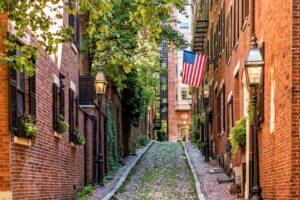Fodor's Expert Review Massachusetts Institute of Technology
Founded in 1861, MIT moved to Cambridge from Copley Square in the Back Bay in 1916. Once dissed as "the factory," particularly by its Ivy League neighbor, Harvard University, MIT mints graduates that are the sharp blades on the edge of the information revolution. It's perennially in the top five of U.S. News and World Report's college rankings. It has long since fulfilled the predictions of its founder, the geologist William Barton Rogers, that it would surpass "the universities of the land in the accuracy and the extent of its teachings in all branches of positive science." Its emphasis shifted in the 1930s from practical engineering and mechanics to the outer limits of scientific fields.
Architecture is important at MIT. Although the original buildings were obviously designed by and for scientists, many represent pioneering designs of their times. Kresge Auditorium, designed by Eero Saarinen, with a curving roof and unusual thrust, rests on three, instead of four, points.... READ MORE
Founded in 1861, MIT moved to Cambridge from Copley Square in the Back Bay in 1916. Once dissed as "the factory," particularly by its Ivy League neighbor, Harvard University, MIT mints graduates that are the sharp blades on the edge of the information revolution. It's perennially in the top five of U.S. News and World Report's college rankings. It has long since fulfilled the predictions of its founder, the geologist William Barton Rogers, that it would surpass "the universities of the land in the accuracy and the extent of its teachings in all branches of positive science." Its emphasis shifted in the 1930s from practical engineering and mechanics to the outer limits of scientific fields.
Architecture is important at MIT. Although the original buildings were obviously designed by and for scientists, many represent pioneering designs of their times. Kresge Auditorium, designed by Eero Saarinen, with a curving roof and unusual thrust, rests on three, instead of four, points. The nondenominational MIT Chapel, a circular Saarinen design, is lighted primarily by a roof oculus that focuses natural light on the altar and by reflections from the water in a small surrounding moat; it's topped by an aluminum sculpture by Theodore Roszak. The serpentine Baker House, now a dormitory, was designed in 1947 by the Finnish architect Alvar Aalto in such a way as to provide every room with a view of the Charles River. Sculptures by Henry Moore and other notable artists dot the campus. The latest addition is the Green Center, punctuated by the splash of color that is Sol LeWitt's 5,500-square-foot mosaic floor.
The East Campus, which has grown around the university's original neoclassical buildings of 1916, also has outstanding modern architecture and sculpture, including the stark high-rise Green Building by I. M. Pei, housing the Department of Earth, Atmospheric, and Planetary Sciences. Just outside is Alexander Calder's giant stabile (a stationary mobile) The Big Sail. Another Pei work on the East Campus is the Wiesner Building, designed in 1985, which houses the List Visual Arts Center. Architect Frank Gehry made his mark on the campus with the cockeyed, improbable Ray and Maria Stata Center, a complex of buildings on Vassar Street. The center houses computer, artificial intelligence, and information systems laboratories, and is reputedly as confusing to navigate on the inside as it is to follow on the outside. East Campus's Great Dome, which looms over neoclassical Killian Court, has often been the target of student "hacks" and has at various times supported a telephone booth with a ringing phone, a life-size statue of a cow, and a campus police cruiser. Nearby, the domed Rogers Building has earned unusual notoriety as the center of a series of hallways and tunnels dubbed "the infinite corridor." Twice each winter the sun's path lines up perfectly with the corridor's axis, and at dusk students line the third-floor hallway to watch the sun set through the westernmost window. The phenomenon is known as "MIT-henge."
MIT maintains a welcome center located at 292 Main Street in Kendall Square, where you can pick up campus maps, grab some water, and charge your phone weekdays 9 to 6.
READ LESS






